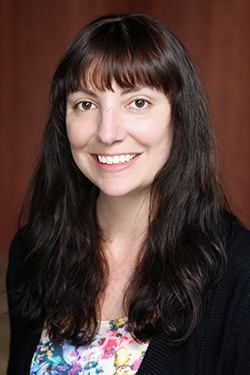Can Robots Make Hospital Treatments Less Traumatic for Sick Children?
Kids with complex medical issues often undergo many painful and traumatic treatments. With help from the SC CTSI, USC pediatrician Margaret Trost is developing a new generation of interactive robot companions to ease the pain.
As a physician who often handles complex, multi-diagnosis pediatric cases at Children's Hospital Los Angeles, Margaret J. Trost, MD, assistant Professor of Clinical Pediatrics, Division of Hospital Medicine, Keck School of Medicine of USC, has treated many patients who had to endure numerous invasive procedures. As it happens, the most common source of pain for kids in hospital treatments is the insertion of intravenous (IV) lines. But despite the best efforts of care providers, these procedures are often painful and traumatic for the young patients.
"We're always trying to make hospital experiences better for kids but they can still be very frightening," Trost said. Technology has been one potential palliative: for example, giving kids electronic games and digital tablets to take their mind off treatments.
I, Robot.
But Trost thought more could be done to make the experience less awful -- even sort of positive -- through the use of technology. The technology she wants to investigate goes way beyond video games: in particular, Trost is studying a branch of interactive robotics called Socially Assistive Robots (SAR).
Trost is working with Jillian Greczeck, a PhD student training under robotics expert Dr. Maja J. Matarić in the USC Viterbi School of Engineering, to adapt a MAKI robot for use in the hospital. MAKI is a human-like, emotive robot that can be replicated at low cost with 3D printers for many different applications. It can be programmed to talk with the kids and play coping games, and a previous study of social robots showed they eased distress for kids getting vaccines. Trost wanted to study SAR interventions with kids receiving IV lines. (For more about Trost's research, view her poster presentation.)
"The goal is to reduce pain and distress, not just to distract them, but also to teach them to develop coping skills," said Trost.
More broadly, Trost realized she had a unique opportunity to contribute to the increasingly important connections between medicine and engineering for years to come. "The field of robotics is really exploding right now, and I love technology and engineering, so I'm in a good position to work with engineers to apply technology in a clinical environment," she said.
For physicians in academia, the demands of teaching, clinical practice, publishing, mentoring and departmental service is a full-time prospect. With schedules and support worked out to the minute and the dollar, it may seem nearly impossible to find the time and the funding to pursue additional training, or make substantial career shifts.
Professional leaps made possible by the SC CTSI.
But Trost wanted to make just such a shift. Developing and testing these new interventions for wide use would require clinical research, in which Trost had limited background. "After years as primarily a clinical physician I wanted to refocus my career more toward research," Trost explained.
Trost went to the Clinical and Translational Research Scholar Program (CTR) at the Southern California Clinical and Translational Science Institute. The CTR program (formerly known as the KL2) is a three-year fellowship created to help health professionals or individuals with research doctoral degrees become clinical and translational researchers. It gives scholars the skills to become clinical investigators supported by major grants from the National Institutes of Health (NIH) and other sources of funding.
The SC CTSI education programs were created in part to capitalize on the insights of clinical physicians and other health care professionals whose real-world experience gives them firsthand knowledge of pressing medical and public health needs. An engineer or academic physician who has not spent a great deal of time in rooms with children undergoing medical treatments might not have been aware of the distress involved, or been equipped to use that empathy to formulate potential new interventions for investigation.
This synergy was readily apparent in Trost's development of a SAR-based intervention. To bring socially assistive into the clinical setting requires coordination between the medical professionals and the engineers who design and build the robots, explained Trost.
"This type of team science is one of the pillars of the SC CTSI's training," she said. "We spend a great deal of time discussing how to communicate and work in these cross-disciplinary environments."
Trost said the training she received through the SC CTSI provided the research knowhow that would have otherwise taken her years to amass, such as trial design, statistics and how to interpret published research as a guide to new research questions. "In fact, I could not have made this leap if it had not been for the SC CTSI's CTR program," she said.
Trost thinks it has also improved her skills as a professor. "I've mentored students myself, but through my experience as a KL2 scholar, my ability to be a mentor has been exponentially improved by the concepts taught by the people I've been in the SC CTSI."




